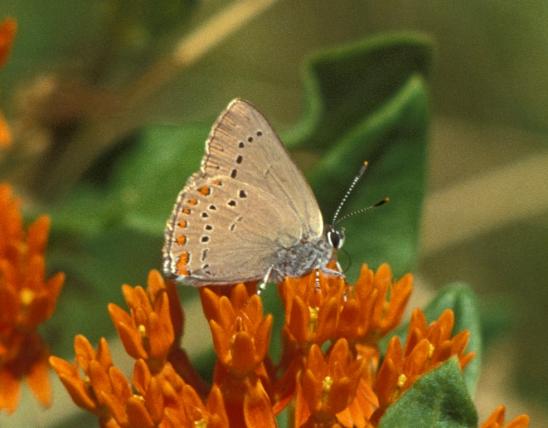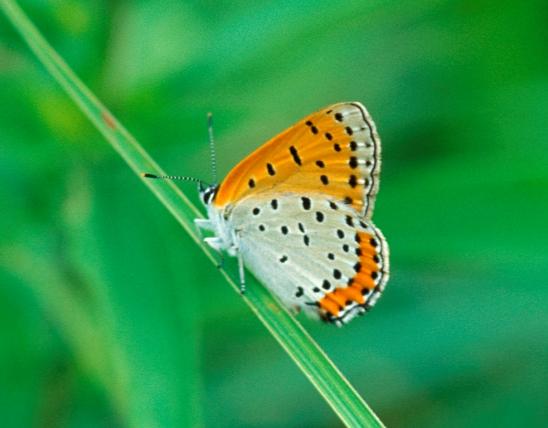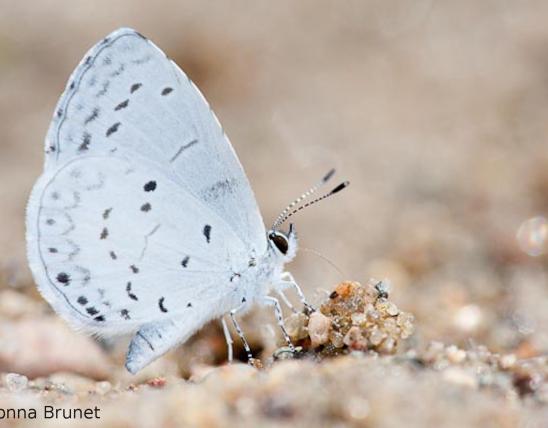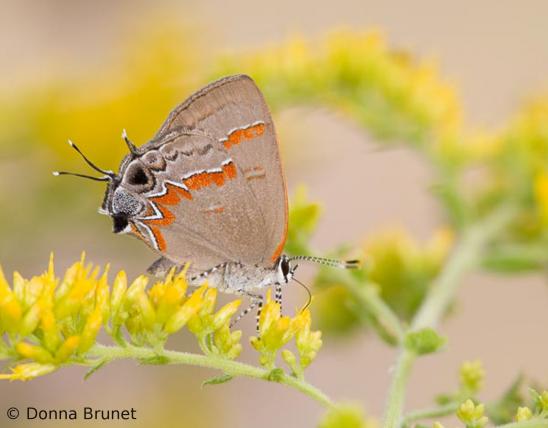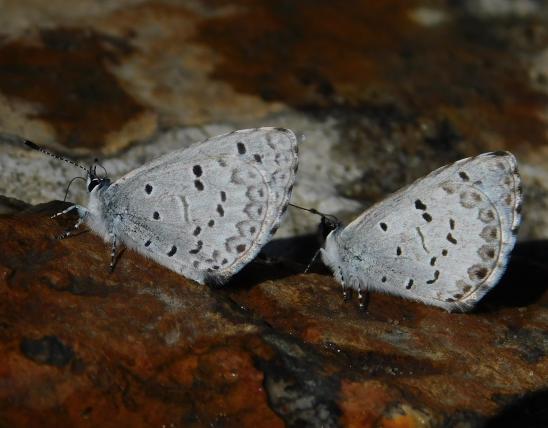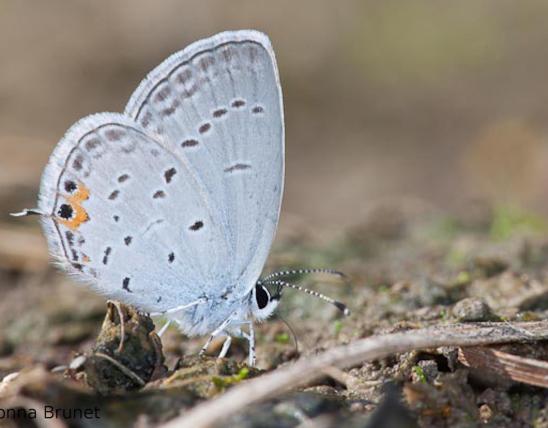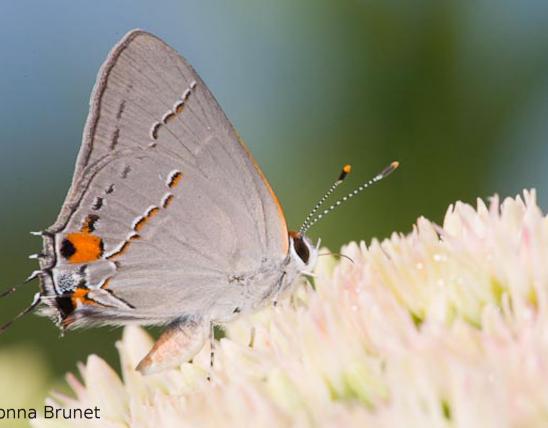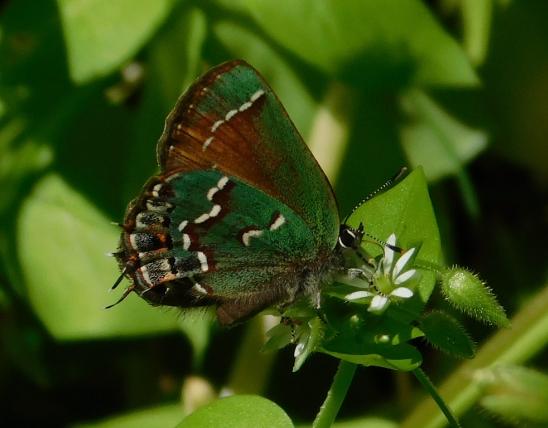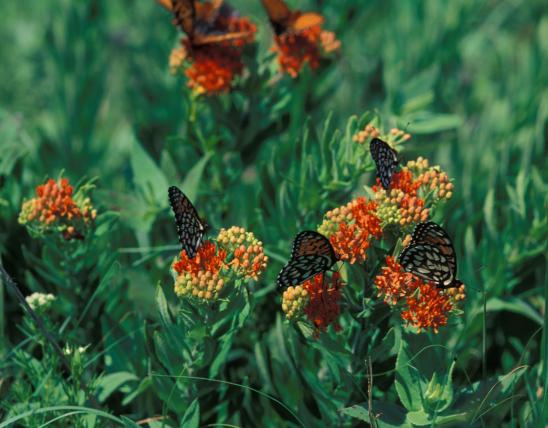
The largest copper on the continent, the great copper is identified by its size, coloration, and markings. The upperside general color is dark gray. Males have only 2 dark spots on the forewing, while females those two plus several more. The hindwing edge has a black border with a pale, orangish wash and a line of black dots inside it. Viewed from below, the wings are grayish white. Males and females both have similar patterns of several black dots and a reddish orange hindwing border. The gray copper’s underside black dots are not organized into lines, but although they seem random, the dot locations are pretty consistent within the species.
Caterpillars are green, rather short and sluglike, and covered with a fine, downy hair. A dark stripe may run down the back.
Similar species:
- The bronze copper (L. hyllus) forewing underside is orange, not grayish white. There are about 20 species of coppers on our continent. Most are smaller.
- Hairstreak butterflies have small, thin hindwing tails and ornate, thin bands on the outer half of the hindwings.
- Blues and azures are smaller and colored with blue.
Wingspan: 1¼–1¾ inches.
Potentially statewide. It is locally abundant in many well-established breeding colonies in western Missouri. In the eastern half of the state, it is rare.
Habitat and Conservation
In the western half of Missouri, this species in locally abundant in colonies in flat, fairly wet, open areas, including moist pastures, damp roadside ditches, low prairies, and grassy, open areas along streams.
Food
Caterpillar host plants include various species of docks and sorrels (genus Rumex), including bitter dock (R. obtusifolius), and other members of the knotweed/buckwheat family.
Adults visit a wide range of flowers, including butterfly weed (a milkweed), Indian hemp (dogbane), and pale purple coneflower.
Status
Locally abundant breeding resident in western Missouri.
The gray copper is sometimes considered a subspecies (ssp. dione) of the great copper (Lycaena xanthoides), a very similar butterfly that otherwise does not occur in Missouri. This is why it is sometimes called the great copper.
Life Cycle
There is a single brood. Eggs overwinter and hatch in the spring. The caterpillars form short, thick pupae that are attached with silk to leaves of the food plant. They emerge as adults in late spring. Males emerge about a week before the females, presumably to get a head start on establishing territories. Adults fly from late May to the middle of July. Males perch on plants and occasionally sally out to patrol their territories, shooing away other males and wooing females. Females lay eggs singly, at the bases of suitable larval food plants.
Human Connections
Apparently, the life cycle of this species is little known. A careful and dedicated observer in western Missouri could increase our knowledge about this pretty little butterfly.
The species name, Dione, is the name of a goddess in Greek mythology, said to be quite beautiful, and often associated with water.
Why is gray sometimes spelled with an “e” instead of an “a”? The spelling with “a” is more common in American English, and the spelling with “e” is more common in British and Canadian English. It’s the same situation with the spellings “color” and “colour.”
Ecosystem Connections
The food plants of this butterfly include the common, weedy, broad-leaved bitter dock plants we see in fallow fields, roadsides, and various sorts of grasslands, and sheep’s sorrel, a common pasture weed. These are members of the buckwheat family, the Polygonaceae. Other relatives include the buckwheat we make pancakes out of, plus several sour-tasting culinary herbs called sorrel. The family also includes the various smartweeds so common along streams, and possibly as weeds in your garden. The invasive Japanese knotweed is also a relative.


























